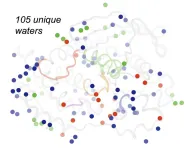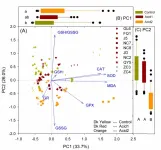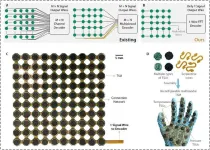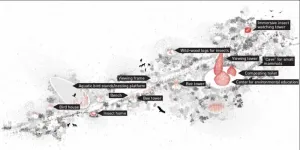(Press-News.org) New research from Oregon Health & Science University for the first time reveals the function of a little-understood junction between cells in the brain that could have important treatment implications for conditions ranging from multiple sclerosis to Alzheimer’s disease, to a type of brain cancer known as glioma.
The study published today in the journal Nature Neuroscience.
Neuroscientists focused on the junction, or synapse, connecting neurons to a non-neuronal cell, known as oligodendrocyte precursor cells, or OPCs. OPCs can differentiate into oligodendrocytes, which produce a sheath around nerves known as myelin. Myelin is the protective sheath covering each nerve cell’s axon — the threadlike portion of a cell that transmits electrical signals between cells.
The study found that these synapses play a pivotal role in producing that myelin.
“This is the first investigation of these synapses in live tissue,” said senior author Kelly Monk, Ph.D., professor and co-director of the Vollum Institute at OHSU. “This gives an understanding of the basic, fundamental properties of how these cells work in normal development. In the future, we might look at how they function differently in the context of MS patients.”
The fact that these synapses exist at all was the subject of a landmark discovery by OHSU researchers at the Vollum that was published in the journal Nature in May of 2000. Until that point, synapses in the brain had been known only to carry neurotransmitters between neurons, so the discovery of a synapse between neurons and OPCs came as a revelation.
“After two decades, we still didn’t know what these synapses do,” Monk said.
Scientists tackled the problem by using single-cell imaging of live tissue in zebrafish, whose transparent bodies enable researchers to see the inner workings of their central nervous system in real time. Using powerful new tools in imaging, pharmacology and gene editing, researchers were able to use neuron-OPC synapses to predict the timing and location of the formation of myelin.
The findings are likely the tip of the iceberg in terms of understanding the importance of these synapses, said lead author Jiaxing Li, Ph.D., a postdoctoral fellow in Monk’s lab.
Oligodendrocyte precursor cells comprise about 5% of all cells in the brain — meaning the synapses they form with neurons could be relevant to many disease conditions, including the formation of cancerous tumors.
Li noted that previous studies have suggested a role for OPCs in a range of neurodegenerative conditions, including demyelinating disorders such as MS, neurodegenerative diseases such as Alzheimer’s and even psychiatric disorders like schizophrenia.
By demonstrating the basic function of the synapse between neurons and OPCs, Li said the study may lead to new methods of regulating OPC function to alter disease progression. For example, these synapses could be the key to promoting remyelination in conditions such MS, where myelin has been degraded. In MS, this degradation can slow or block electric signals required for people to see, move their muscles, feel sensations and think.
“There may be a way to intervene so that you can increase the myelin sheath,” he said.
Monk said the discovery may be most immediately relevant to cancer.
“In glioma, these synapses are hijacked to drive tumor progression,” she said. “It may be possible to modulate the synaptic input involved in tumor formation, while still allowing for normal synaptic signaling.”
Even though these precursor cells comprise roughly 5% of all human brain cells, only a fraction go on to form oligodendrocytes.
“It’s becoming pretty clear that these OPCs have other functions aside from forming oligodendrocytes,” Monk said. “From an evolutionary perspective, it doesn’t make sense to have so many of these precursor cells in your brain if they’re not doing something.”
Their synaptic connection to neurons therefore likely plays a fundamental role in the brain, and is worthy of future exploration, she said.
In addition to Monk and Li, co-authors include Tania Miramontes of OHSU and Tim Czopka, Ph.D., of the Centre for Clinical Brain Sciences at the University of Edinburgh in the U.K.
The research was supported by the National Multiple Sclerosis Society postdoctoral fellowship, award FG-1907-34613 and the Warren Alpert Distinguished Scholar Award to Li; the National Institute of Neurological Disorders and Stroke (NINDS) of the National Institutes of Health, award number F31NS130898 to Miramontes; and NINDS award number 1R21NS120650 to Monk. The content is solely the responsibility of the authors and does not necessarily represent the official views of the NIH.
All research involving animal subjects at OHSU must be reviewed and approved by the university’s Institutional Animal Care and Use Committee (IACUC). The IACUC’s priority is to ensure the health and safety of animal research subjects. The IACUC also reviews procedures to ensure the health and safety of the people who work with the animals. No live animal work may be conducted at OHSU without IACUC approval.
END
Study reveals function of little-understood synapse in the brain
Discovery could be useful in developing new therapies for multiple sclerosis, neurodegenerative conditions, brain cancer
2024-01-12
ELSE PRESS RELEASES FROM THIS DATE:
Spying on a shape-shifting protein
2024-01-12
NEW YORK, January 12, 2024 — Proteins do the heavy lifting of performing biochemical functions in our bodies by binding to metabolites or other proteins to complete tasks. To do this successfully, protein molecules often shape-shift to allow specific binding interactions that are needed to perform complex, precise chemical processes.
A better understanding of the shapes proteins take on would give researchers important insight into stopping or treating diseases, but current methods for revealing these dynamic, three-dimensional forms offer scientists limited information. To address this knowledge ...
Researchers sequence the first genome of myxini, the only vertebrate lineage that had no reference genome
2024-01-12
An international scientific team made up of more than 40 authors from seven different countries, led by the researcher at the University of Malaga Juan Pascual Anaya, has managed to sequence the first genome of the myxini –also known as ‘hagfish’–, the only large group of vertebrates for which there was no reference genome of any of its species yet.
This finding, published in the scientific journal ‘Nature Ecology & Evolution’, has allowed deciphering the evolutionary history of genome duplications –number of times a ...
Researchers uncover blood flow regulation of brain pericyte development
2024-01-12
In a study published online in Cell Reports, DU Jiulin’s group at the Institute of Neuroscience, Center for Excellence in Brain Science and Intelligence Technology of the Chinese Academy of Sciences, and the collaborators, created a zebrafish model for in vivo labeling of brain pericytes and systematically explored the developmental dynamics of brain pericytes during the early embryonic stage. The researchers revealed the promoting effect of blood flow on the proliferation of pericytes after ingress into the brain and showed that this process ...
Divergent responses of growth rate and antioxidative system of ten Bacillus strains to acid stresses
2024-01-12
Soil aciditification is widely occurring in diverse terrestrial ecosystems and soil microbial communities have been reported to be highly sensitive to changes in soil pH. Soil microbes could regulate their physiological conditions to make them survive under the aciditifying conditions. This study demonstrates that ten Bacillus strains are able to regulate the antioxidative system differently in response to the decreasing environmental pH condition, and therefore have different acid tolerance capacity. The researchers’ ...
HKUST researchers develop a versatile, reconfigurable, and damage-tolerant single-wire sensor array
2024-01-12
Researchers from The Hong Kong University of Science and Technology (HKUST) have developed a sensor array design technology inspired by the human auditory system. By mimicking the human ear's ability to distinguish sounds through tonotopy, this innovative sensor array approach could optimize the application of sensor arrays in fields such as robotics, aviation, healthcare, and industrial machinery.
Traditional sensor arrays face challenges such as complex wiring, limited reconfigurability, and low damage resistance. The design developed by the HKUST team, led by Associate Professor YANG Zhengbao from the Department of Mechanical & Aerospace ...
Between building and unbuilding: An interdisciplinary design approach to cohabitation, material cycles, and traditional ecological knowledge
2024-01-12
In recent history, built environment practices have accepted a paradigm which underlines the land’s static quality, prioritizes immediate utility, and consequently adopts design processes that inevitably accelerate assimilation. With the capitalist propensity to obtain control and enhance efficiency, those processes nevertheless privilege certain cultures while rejecting other forms of knowledge or living specific to the land. The design discourse, confronted with the rising pressure of global climate challenges and environmental inequity, suggests a ...
Team explores role of STING – stimulator of interferon genes – in body’s innate immune system
2024-01-12
When pathogens attack the body, the innate immune system goes to work protecting against the invading disease. The innate immune system is the first line of defense. It detects precisely what the virus or bacteria is and then activates the proteins that fight the pathogens. Wanting to better understand how the body’s innate immune system works, a team of scientists undertook a study of STING, a protein that plays a vital role in innate immunity.
The team provides quantitative results, showing how STING, an acronym for stimulator of interferon genes, works in innate immune signaling.
Their work is published in the journal Nature Communications on Jan ...
New Antarctic research shows that Adélie penguins must balance the benefits and costs of riding on sea ice during their long-distance migration
2024-01-12
Petaluma, CA--Newly published research by Petaluma-based non-profit, Point Blue Conservation Science, shows how Adélie penguins within the Ross Sea, Antarctica use sea ice in their annual migrations. The results were published in the journal Ecology, a publication of the Ecological Society of America.
Adélie penguins, though flightless, can undertake extraordinary migrations like their flying relatives, traveling thousands of kilometers out to sea from their on-land breeding colonies in Antarctica, tracking daylight and food during the long Antarctic winter. Many other species are known to use wind ...
Antibiotic use is not the only driver of superbugs
2024-01-12
For the first time, researchers have analysed the impact of antibiotic use on the rise of treatment-resistant bacteria over the last 20 years in the UK and Norway. They show that while the increase in drug use has amplified the spread of superbugs, it is not the only driver.
Researchers from the Wellcome Sanger Institute, the University of Oslo, the University of Cambridge, and collaborators, conducted a high-resolution genetic comparison of bacteria. They compared over 700 new blood samples with nearly 5,000 ...
Two common biomarkers predict heart risk in asymptomatic childhood cancer survivors
2024-01-12
(MEMPHIS, Tenn. – January 11, 2024) Data from the St. Jude lifetime cohort study (St. Jude LIFE) revealed that two common biomarkers of cardiac function and damage could better predict cardiomyopathy within five years than routine clinical evaluations in high-risk, asymptomatic childhood cancer survivors. Early detection through screening using these two biomarkers may lead to earlier treatment to prevent and protect against further heart damage. The findings were published today in the Journal of Clinical Oncology.
Cardiomyopathy is often asymptomatic at onset and thus “invisible” to routine clinical evaluations. St. Jude ...
LAST 30 PRESS RELEASES:
Why a life-threatening sedative is being prescribed more often for seniors
Findings suggest that certain medications for Type 2 diabetes reduce risk of dementia
UC Riverside scientists win 2025 Buchalter Cosmology Prize
SETI Institute opens call for nominations for the 2026 Tarter Award
Novel theranostic model shows curative potential for gastric and pancreatic tumors
How beige fat keeps blood pressure in check
Fossils reveal ‘latitudinal traps’ that increased extinction risk for marine species
Review: The opportunities and risks of AI in mental health research and care
New map reveals features of Antarctic’s ice-covered landscape
Beige fat promotes healthy vascular function and blood pressure in mice
Chronic low-dose pesticide exposure reduces the life span of wild lake fish, China-based study shows
Tiny earthquakes reveal hidden faults under Northern California
Long-term pesticide exposure accelerates aging and shortens lifespan in fish
Professor Tae-Woo Lee's research group develops groundbreaking perovskite display technology demonstrating the highest efficiency and industry-level operational lifetime
The “broker” family helps tidy up the cell
Ecology: Mummified cheetahs discovery gives hope for species’ Arabic reintroduction
Researchers survey the ADHD coaching boom
Air pollution and cardiac remodeling and function in patients with breast cancer
Risk of suicide in patients with traumatic injuries
Post–intensive care syndrome
The lifesaving potential of opioid abatement funds
The Frontiers of Knowledge Award goes to Allan MacDonald and Pablo Jarillo-Herrero for their discovery of the “magic angle” enabling science to transform and control the behavior of new materials
Discovery reveals how keto diet can prevent seizures when drugs fail
JMIR Publications and Sikt announce pilot flat-fee unlimited open access partnership
Finding new cell markers to track the most aggressive breast cancer in blood
A new, cleaner way to make this common fertilizer
Fire-safe all-solid-state batteries move closer to commercialization
Disinfecting drinking water produces potentially toxic byproducts — new AI model is helping to identify them
Unplanned cesarean deliveries linked to higher risk of acute psychological stress after childbirth
Healthy aging 2026: fresh pork in plant-forward diets supported strength and brain-health biomarkers in older adults
[Press-News.org] Study reveals function of little-understood synapse in the brainDiscovery could be useful in developing new therapies for multiple sclerosis, neurodegenerative conditions, brain cancer







